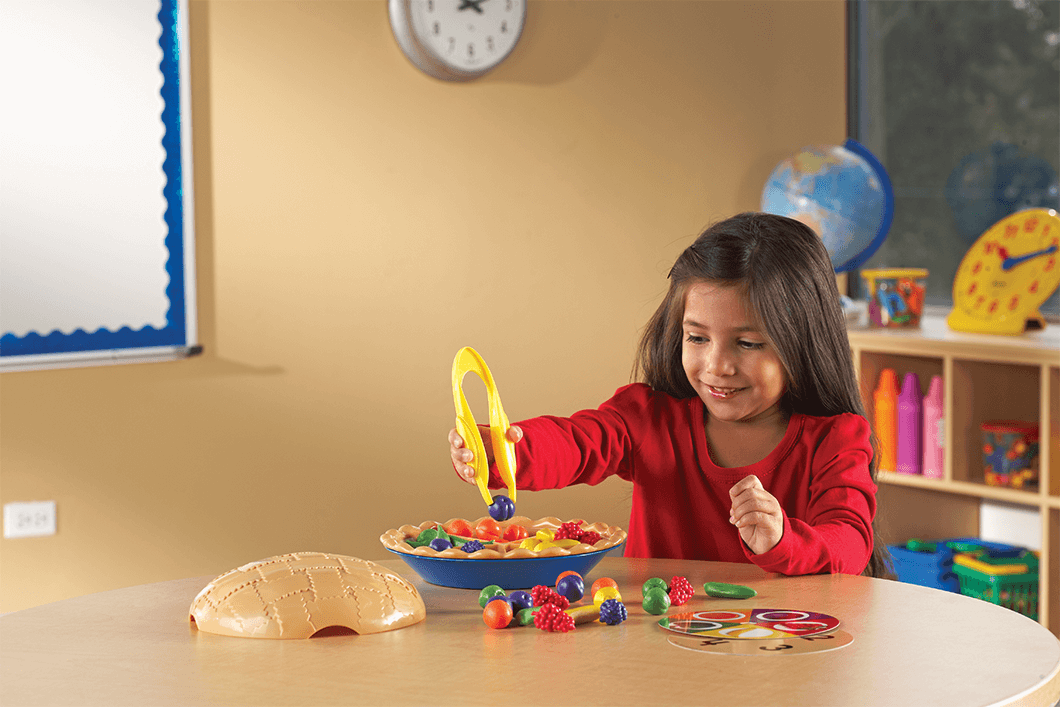
Ten Activities to Develop Fine Motor Skills
- Learning Resources Posted On Jul 29, 2021 | Seasonal Fun
Fine motor skills are about the small muscle movements in the fingers, hands and forearms. These skills develop over time as children interact with the world around them. As children improve their fine motor skills they will become able to perform controlled and stable movements as well as learning to do more things with their hands independently such as:
- Holding a pencil
- Tying their shoelaces
- Feeding themselves
- Cutting along straight and curved lines
- Opening lunch boxes
- Drawing circles and crosses
- Building things with blocks
- Making sculptures with materials like Playfoam®
Dr Amanda Gummer from the Good Play Guide has grouped fine motor skills into three areas: grasping, manipulating, and hand-eye coordination. While fine motor skills develop naturally from birth, they won’t develop without practise and that’s where play comes in! Activities that involve lacing, stacking and squeezing all help to support this developmental area whilst children also have fun.
Ten activities to develop fine motor skills that you can try at home:
1. Playfoam arts & crafts


Playfoam is a squishy-squashy sculpting toy perfect for mess-free creative play! Its bead-like texture also makes it ideal for sensory play, and it never dries out so your child can use it again and again! Squishing, squashing, and sculpting with Playfoam helps to strengthen the muscles in little hands. Learning Resources has loads of Playfoam packs - try Playfoam Combo 8-Pack, or for fun sculpting fun on the go, try Playfoam Go Squishy Sandcastle.
"Modelling the foam has the added bonus of improving hand and finger strength and coordination, skills that are needed for holding a pencil to write.” - Good Play Guide
Find 25 more fun Playfoam craft ideas you can try at home or in the classroom.
2. Magnet fishing


Place some magnetic letters and numbers into a large bowl and create a ‘fishing rod’ by attaching a paperclip to a piece of string. Encourage your child to use the fishing rod to catch letters and numbers. Ask them to find a specific letter; this will encourage them to make focused and controlled movements. Extend the activity into letter or number recognition by asking questions about what’s been ‘caught’, such as:
- What words do you know that begin with this letter?
- What letter comes after this one in the alphabet?
- What numbers add up to make this number?
- What is the sum of this number + 2?
3. Super Sorting


Categorise counters by colour, number or attributes with a sorting set such as the Super Sorting Pie. Use Jumbo Tweezers to pick up counters and place them into the correct section. Tweezers reinforce fine motor skills, helping to develop the pincer grip which involves using your thumb and pointer finger together to grab things. The pincer grip is needed to hold and write with a pencil.
4. Alphabet lacing


Lacing activities help strengthen hand and wrist muscles as well as developing the pincer grip. Use lacing letters to combine lacing with literacy skills and encourage children to thread different words and phrases. This activity will also help young learners become aware of the roles of their dominant and non-dominant hands.
"The letters are easy to handle and the threading laces benefit from a nice long tip meaning that Amy was perfectly able to thread the letters on for the sake of a fine motor skills activity working alongside her big sister!” - Colette from "We're Going on an Adventure"
5. Sticker line up


For this activity you will need a roll of paper, a marker pen and some stickers. Roll out 2-3 metres of paper, cut it out and masking tape it to a hard floor or surface. Using the marker pen, draw a long line with lots of different shapes and swirls along it. Give your child some stickers and ask them to place them along the line. This activity is great for building concentration skills while also helping them to develop hand-eye coordination and pinching techniques.
6. Wriggle worms


The early player catches the worm and some fine motor skills along the way. Wriggleworms! Fine Motor Activity Set is a fun game were players use the specially-designs Tri-Grip Tong to grab stretchy worms from the soft foam activity board. The tong features intuitive finger placements which helps children get used to the position and feeling of holding a pencil. The game also introduces colour identification, sorting, critical thinking and early maths skills.
7. Laundry line up


Hang out the washing and develop fine motor skills with this simple game. You will need to print out pictures of different items of clothing, cut them out and place them into a ‘laundry basket’. You will also need a small wire draining rack and some miniature sized pegs. The aim of the game is to hang out all of the laundry on the wire rack ‘to dry’. Children often learn by watching and imitating others perform an action so begin the game by both taking part. This activity is a fun way to develop hand-eye co-ordination and strengthen finger muscles!
8. Elastic band tin


All you will need for this activity is a food tin and some elastic bands. Challenge your child to fit all of the elastic bands around the tin. Although this seems very simple, it will help to build dexterity and hand strength as your child stretches and manipulates the bands to fit around the tin.
9. Scissor skills with jelly


All children love jelly and this is the perfect activity to create excitement around improving scissor skills and pincer grasp! Correctly holding and using scissors to cut out shapes is a skill that guidelines suggest should be achieved by the age of six. Use jelly cubes straight from the packet and place in a bowl. Give your child some scissors and leave them to snip the jelly into different shapes! They can also use their fingers to tear the jelly, making for fun and simple sensory play.
Want to find some other ways to work on your little ones scissor skills? We have a range of free activity sheets that can be printed out below!
10. Spaghetti Worm Excavation


Combine fine motor skills with early outdoor exploration with a spaghetti worm excavation! You will need a large tray, cooked spaghetti, a jar, tweezers and some slightly damp soil. Place the damp soil into the tray and bury the worms. Give each child a pair of Jumbo Tweezers and let the digging begin! Encourage children to count the worms as they find them and place them in the jar. This activity combines sensory play, outdoor discovery and fine motor skills for a rich learning experience. Jumbo Tweezers feature ergonomic depressions to guide the correct grip which will help develop fine motor control and build handwriting skills.
Bonus tip!


Create a sensory bin using rice or lentils, hide items inside and give your child a set of Helping Hands Fine Motor Tool Set to fish them out.
For more ideas and inspiration, browse our fine motor skills resources on our website and read our blog for more ideas and tips. Download this fun free fine motor skills scavenger hunt activity sheet and keep up the learning!














